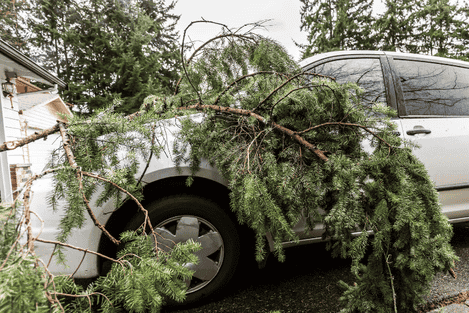
Written by Kayla Jane Barrie Updated on Feb 27, 2025 4 mins read

Extreme weather events are on the rise. While many associate extreme weather events and home insurance, they also pose an increased risk to your vehicle.
2024 became Canada's costliest year for weather disasters, shattering records as extreme weather events—including floods, damaging hail, extreme temperatures, and devastating wildfires—affected millions and caused unprecedented damage to communities and insurance companies. Four events in July and August alone resulted in over $7.7 billion in insured losses.
Many drivers assume they are covered for things like water damage, hail, and fire. But, if you only have the minimum mandatory requirements, you may not be covered for extreme weather events.
Basic car insurance will not provide you with all the protection you need. If you don’t have extended plans, weather damage may not be covered.
Comprehensive provides protection for non-accident related threats and weather events. While all perils provides combines the two, plus additional areas.
Here is what might and might not be covered. Always check your documents to confirm.
Going above and beyond basic requirements can provide your vehicle with protection from flooding. Acts of nature of this kind are covered but may be subject to exclusions and limits.
Find your car underwater? Water damage, or rising water coverage, is often included. You are covered for events that are out of your control, such as a lake or river overflowing, or a significant rainstorm.
Strong winds can cause significant damage to your vehicle. Damage from high winds is typically covered. This includes flying debris that damages your vehicle such, as smashed windows, windshield damage, dents, and more.
Falling trees, branches, and other objects are typically covered. It will help pay to repair or replace your vehicle if it’s damaged by a falling tree. You will be covered regardless if the tree is on your property or your neighbour’s.
Fires as a result of a collision with another vehicle or object are covered under collision. This includes fires from faulty wiring, engine fire, natural disaster, fire spreading from a house fire, or a thief burning a vehicle after it’s been stolen will be included in comprehensive.
While lightning strikes on vehicles are rare, they do happen. Damage is included in most policies. It will help pay for repairs related to the damage such as electrical issues, car fire, and body damage.
While many weather events are not preventable, drivers can do a number of things to protect their vehicle. Here is what you can do to reduce the odds of a car insurance claim :
If you are thinking about filing a car insurance claim for weather damage, always compare the damage costs with your deductible. It may make more sense to pay out of pocket than to file and risk increasing your costs.
The amount of protection your vehicle will have from severe weather damage will depend on the type of plan you have. Check your documents and speak with your advisor to confirm what you are covered for.
Depending on your provider and plan, you will likely not see a high increase in your payments from submitting damages from hail. If you can cover the repairs without submitting them, that is often recommended.
Yes. Most policies cover hail storm damage. It might be named specifically or fall under storm damage in your document. When big enough, hailstones can do damage to your vehicle’s roof, windshield and body. They cause small dents, and the cost to repair depends on the size of hail, depth and number of dents.
Many drivers assume all forms of weather damage are covered in their Ontario car insurance. However, some weather events and natural disasters may be excluded or have limited protection, such as tornadoes, hurricanes, earthquakes and flooding. You may be able to purchase optional enhancements for extra protection. Know your area and the risks that can be posed to your vehicle.
| Categories | Auto |
|---|---|
| Tags | Repairs and MaintenanceAuto Coverage |
Read our insurance blog to get helpful tips, information and news.
Has your car been totalled in an accident? Is your car a write off? Learn about vehicle write offs for a total loss insurance claim.
Get the facts on Toronto's auto theft problem. We break down the data, reveal the most-stolen vehicles (including the Honda CR-V and Lexus RX 350), and show which neighbourhoods are most affected.
Dive into the world of auto theft with our blog on the most stolen cars in Canada. See the most stolen cars across Canada, including provincial lists for Ontario and Quebec, and learn how high-risk models can affect your car insurance premiums.
Drive safe this winter! Check out these tips for driving in snowy and icy conditions in Ontario. Get other helpful info and FAQs on winter driving.